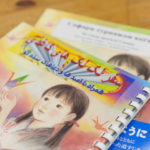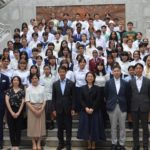1 Escalation of World War II and Group Evacuation of School Children
When the Atomic Bomb was dropped, approximately 400 children were at then-Honkawa National School (presently Honkawa Elementary School), all of whom were killed4). Under such a desperate situation, however, students and teachers who returned from the evacuation took the lead in reconstruction after the war.
As the war escalated in 1944, the Japanese mainland became a target of attacks. Amidst the continuing worsening of the course of the war, the Japanese government issued guidelines on the evacuation of schoolchildren (Gakudo-sokai Jisshi youryou), according to which schoolchildren above the third grade were to be moved from urban areas to rural areas. This was the so-called school evacuation policy. In Hiroshima city, evacuations were implemented from April to July, 1945. Most of the national elementary school students older than third grade (approximately 23,500) evacuated to mountainous areas in the north of the prefecture. Children who had their relatives or acquaintances in the countryside were taken to their homes (nearly 15,000). Children with no relatives or acquaintances lived in temples as groups and went to the nearest schools5).
At Honkawa National School, 500 students were taken to their relatives or acquaintances, 205 students and 10 faculty members evacuated as a group6). Students past the third grade moved to Tokaichimachi (8 faculty members and 140 students) and Yatsugimura (28 faculty members and 65 students) in Futami-gun (present-day Miyoshi city 7). The memoirs of a schoolchild recount the day of the group evacuation. “At that time, a song titled ‘Walk, Walk’ was released. We marched to Hiroshima Station from Toukaichi in order. It did not feel like I was evacuating. It felt like a picnic. I was more excited about getting on a train for the first time. Japanese national flags were flapping8) ” The diarist continued: “Saying good-bye to family members was hard to endure. There were parents and children who could not part from each other, and some friends were crying loudly. I could not find words to express it.9) ” When arrived at the destination, “we were transferred to schools in Toukaichi in groups and started school life with local children. The river bank situated behind the Tokaichi National School was lined with cherry trees and they were in full bloom. As classes started, we from the city began in a spirit of competition with the local children. 10)”
However, in actuality, “we had few classes but a lot of work11)” including getting rid of harmful insects in paddy fields at the behest of their school, and spending whole days collecting edible plants to be sent to the army12). Life at the temples was misery. For example, at a temple where about thirty boys in the third through sixth grades stayed, they ate rice mixed with soy, stems of radishes and potatoes, and grilled bullfrogs caught in rice paddies. A teacup full of soy beans was often provided as a snack, but it was not filling. Hence, after sunset, children stole tomatoes and cucumbers in the fields that they marked out on their way back from school13). Even when teachers recognized this, they could not scold the children, out of sympathy14). In addition, hygiene was poor. Because they went to a public bath only once a week, they bred lice on their bodies. There was no medicine. Students picked at lice as a routine 15). Despite the harsh conditions, children were sometimes able to enjoy such a life.
4)One teacher and one child were confirmed to have survived in a later investigation.(Ibid.pp.3)
5)City of Hiroshima (Ed.). Hiroshima Genbaku Sensaishi: Daiikkan (Record of the Hiroshima A-bomb War Disaster, Vol.1). pp.194-195
6)Hiroshimashi Taishoku Kouchoukai (Association of Retired Principals in Hiroshima) (Ed.), (1999), Senchu Sengo ni Okeru Hiroshimashi no Kokumin Gakko Kyouiku(National School Education in Hiroshima during and after the War), p.291
7)Ikuma Hirasue (1933), p.3
9)Takashi Wakasa, “Kinenshi ni Yosete” (On Commemorative Publication), In Souritsu 120 Shunen Honkawa (120thAnniversary of Honkawa) Hiroshima Honkawa Elementary School, p.8
10)Youji Araki (1999), p.130
11)Ibid. p.130
12)Ibid. p.130
13)Ibid. p.131
14)Masako Yamamoto (1993),“Wasureenu Omoide” (Unforgettable Memory), In Souritsu 120 Shunen Honkawa (120th Anniversary of Honkawa) Hiroshima Honkawa Elementary School, p.9
15)Youji Araki (1999), p.131








